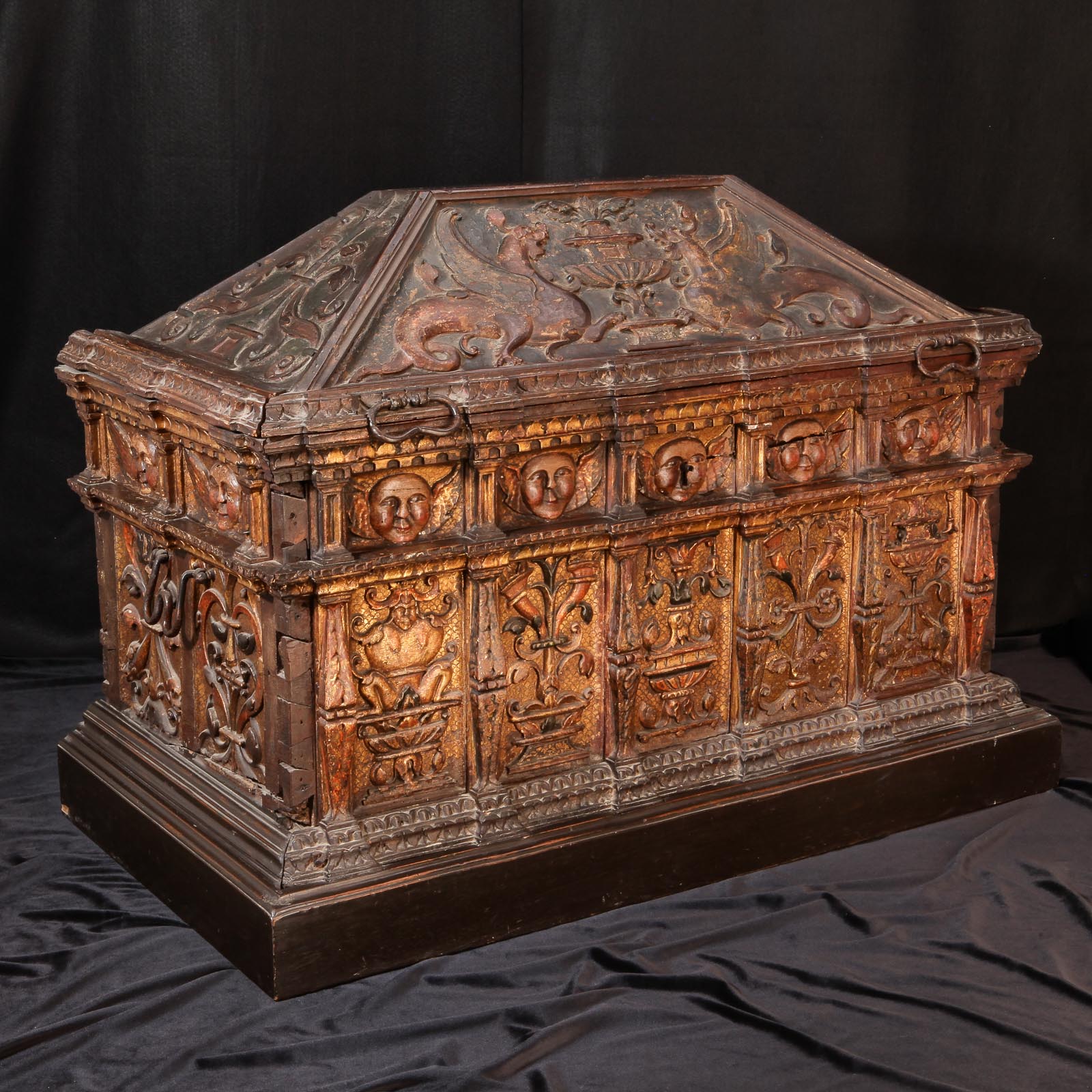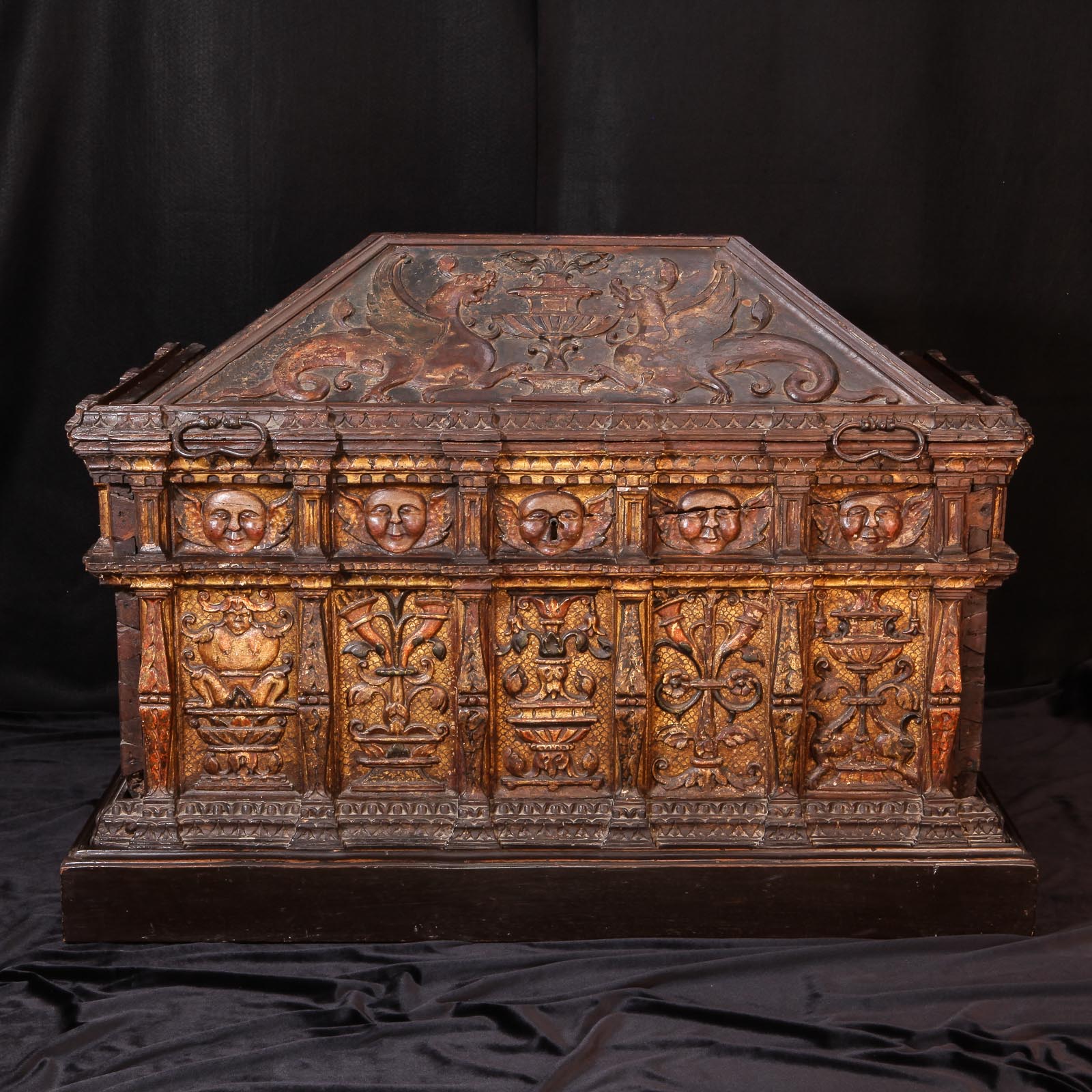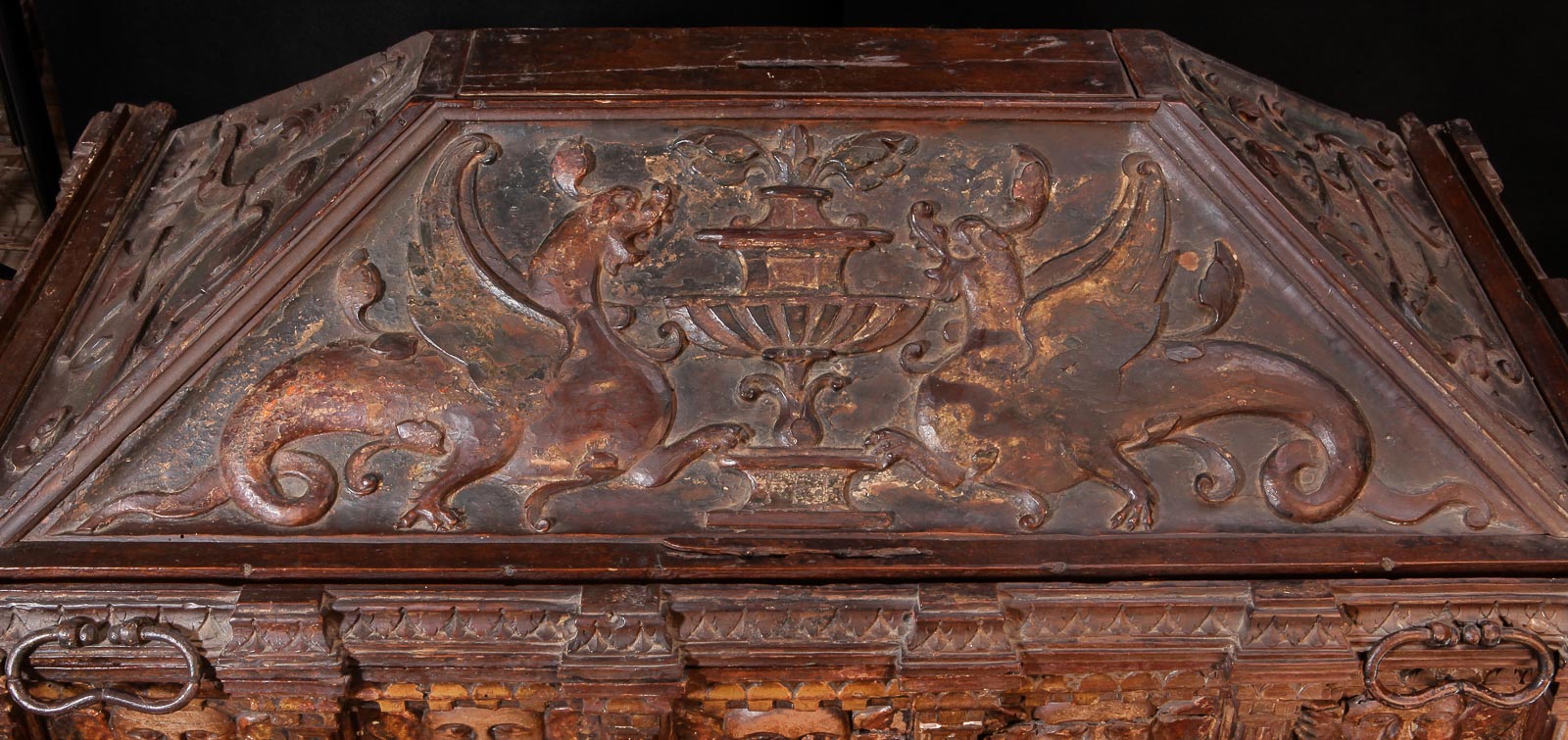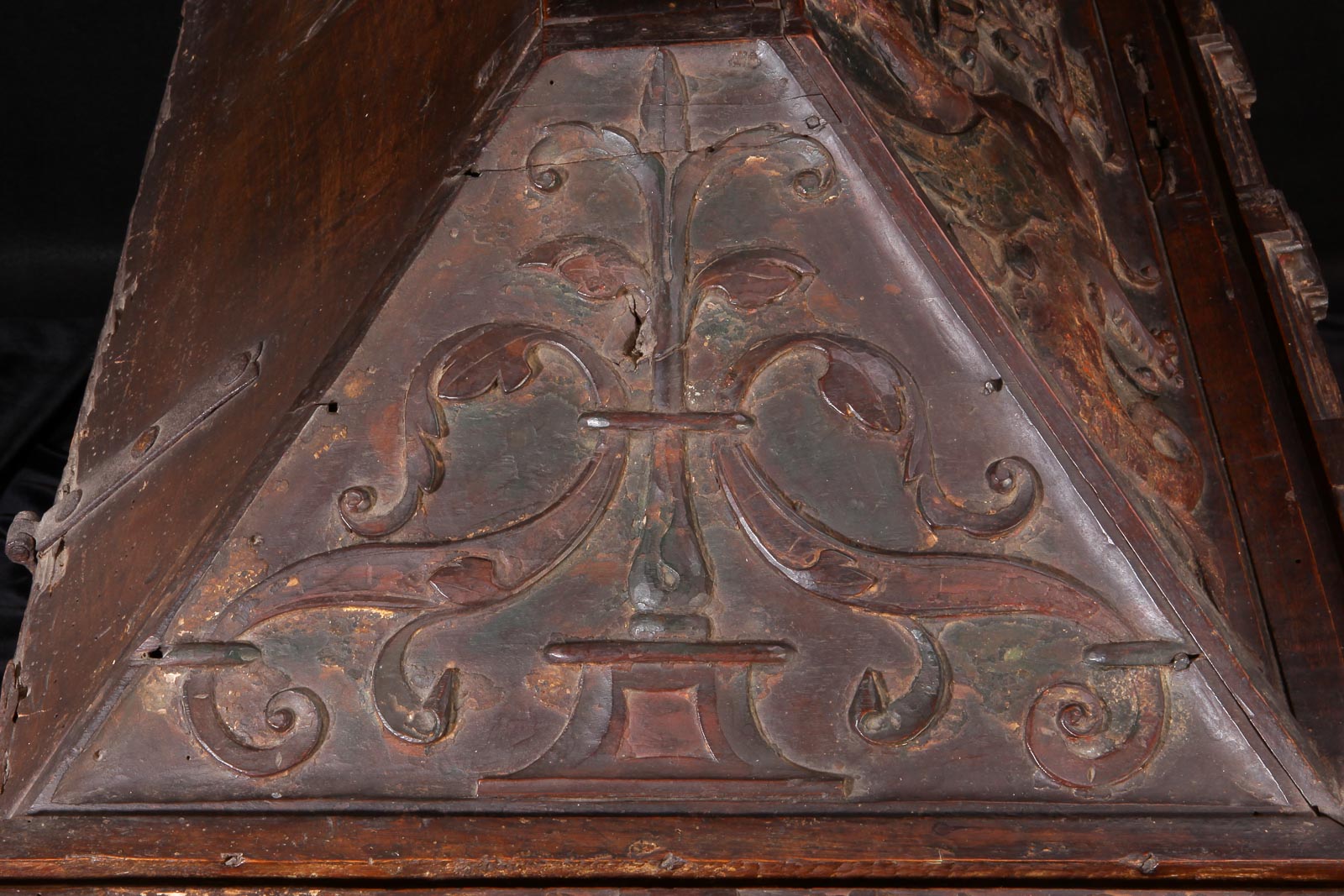16th century parcel gilt walnut chest
1510 - 1540
England or Europe
W 41 1/4" × H 25 1/2" × D 23 1/4"
SOLD
A MAGNIFICENT AND RARE PAINTED AND PARCEL-GILT WALNUT AND PINE BOARDED CHEST, PROBABLY ITALIAN, OR MADE BY ITALIAN CRAFTSMEN ELSEWHERE, CIRCA 1510 – 1540
Of architectural sarcophagus form, the front and side boards joined by dovetails and carved from the solid with applied mouldings and balusters, the hipped lid with flat top board, pierced with a sunken reserve drilled with a pair of holes, the front board carved with a chalice raised on a waisted plinth and between a trio of leaves, flanked to either side by a pair of winged mythical beasts with curly tails, the right proper end of the lid carved with a balustroid plant with scrolling leaves, on a waisted 'panelled' plinth, the left proper end centred by an acanthus-clad chalice beneath scrolling leaves and between beaded foliate scrolls, the top rear plank with strap hinges fixed by three nails, and the lid with applied moulded and leaf-carved edge following the lines of the projecting pilasters to the front and sides, a rebate or channel running behind the mouldings, the lid's front and side edges with iron bale handles, shaped and fixed by loops and with knop terminals, the front and sides conceived in two registers, the upper frieze or architrave carved with winged masks between applied 'panelled' pilasters, the lower register taller, the front of five panels, the far proper right panel with a squatting chubby grotesque with scroll-ended hat, and foliated scroll arms atop a gadrooned urn, the remaining panels to the front carved as urns issuing foliage and cornucopia, the end panels conforming, all panels to the lower register spaced by applied projecting rectangular-section addorsed foliate-carved balusters, a double-run of leaf-carved moulding below, the underside of the lid probably later painted in blue and with gilt stars, elsewhere painted all over with pigments upon a gypsum ground, the gilt ground punched with scales, the pilasters decorated with delicate line-painted foliage, the lock attached to the inside and overlapping the top edge of the front board and fixed with nails, all raised on a later detachable plinth.
Provenance:
- Reputedly purchased Sotheby's in the 1980s.
- Thence to the collection of the Straus family of Pound Ridge, New York.
- Thence private collection of Paul Fitzsimmons Esq.
Use:
With undecorated rear boards to both the body and lid, this chest was clearly designed to stand against a wall; its handles suggest that it was also designed to be portable. It is entirely Renaissance in character, its form that of antique sarchopagi and its decoration the all'antica motifs of the early Renaissance. The decoration to the lid and to the large 'panels' to the front and sides is entirely secular, but the repeated winged masks to the frieze, indicative of the celestial, possibly point to a religious use. This is consistent with the painted decoration to the underside of the lid - gold stars against a blue sky - a scheme also found on painted ceilings of churches and chapels of the same period. Nonetheless, the fact that the underside is recently painted makes it difficult to be certain, even if it would be reasonable to suppose that the later decoration mimics what preceded it.
Chests were used to house relics or bones, and the closest parallels to this chest in England are the mortuary chests which sit atop the Presbytery screen of Winchester Cathedral. Originally eight (or possibly ten) in number, there are now six. Several were damaged (at least emptied) during the Civil War, and so two of the surviving six are 17th century replacements. The other four are said to have been made under the aegis of Bishop Richard Fox (1448 – 1528), who, having commissioned the building of a chantry chapel and screens in the Cathedral's nave in the first quarter of the 16th century, re-housed the bones of Anglo-Saxon and later English kings and their queens. The Winchester mortuary chests are of oak and boarded in the English manner rather than made with dovetails (a method more common in France). They also have gabled lids rather than the hipped lid to this example, but it is interesting to note nonetheless that they share certain features. Bishop Fox's chests are all topped by a shield, and this chest has a sunken reserve to the board which forms its flat top, pierced with a pair of holes, either for a mount of some kind or a handle, which is now lacking. In addition, the mouldings which edge the top to the front and sides of both this and the Winchester chests sit before a rebate, the purpose of which is not entirely clear, but which may have been intended to hold a low gallery or rail. Furthermore, both this chest and the Winchester chests are painted, and their fronts designed as two registers, a slender upper section above a taller section below. It is therefore possible that these shared features reflect the fact that this chest was itself a mortuary chest.
Form:
The shape of this chest is comparable with the caskets popular in Italy in the 15th and 16th centuries, which were frequently decorated with pastiglia.
These caskets were betrothal gifts from a groom-to-be to his prospective bride. This chest is considerably larger, and more obviously resembles a cassone in terms of its size, although the latter, on the whole, tend to be wider and lower in their proportions. If anything, it most closely resembles a type of chest – of which few examples appear to survive – illustrated in a late 15th century drawing by Francesco Colonna (1433 - 1527): the, cassa alla ferrarese (literally 'from Ferrara') a straight-sided chest standing upon a plinth, with a heavily corniced lid that was square-domed.
Some châsses reliquaires of late Medieval and Early Modern France, as well as reliquaries made in Italy during the same period, share the same straight sides and hipped lid. It is worth noting in this context that Italian reliquaries also appear in paintings topped by icons or statues, as per the possible purpose of the reserves and rebates to the lid as noted above.
Decoration & Materials:
The chest is made of walnut and pine or poplar, certainly materials used in France at this period, but, when used together, more commonly in Italy. The keyhole, punched straight through the decoration of the frieze, is also an Italian feature. French coffers of this period tend to be fitted with a decorative lockplate accommodated by the design, with uncarved space left to the front board to incorporate it.
This chest's polychrome decoration comprises mixed greens (as opposed to the copper greens which were typically used in England, both before and beyond the Reformation), and the paint is applied in places over a layer of plain hand-woven linen, a technique commonly used in north European panel painting. Over the linen, however, a gesso layer of gypsum has been used, which present scholarship suggests is not consistent with north European polychromy. Painted media in the first half of the 16th century, both in England and the Low Countries, normally contain chalk as the 'inert white material' used to prepare the painted ground. The mortuary chests at Winchester Cathedral, for example, are painted over a chalk ground. Gypsum layers are generally associated with southern European painting methods, typically those of Italy, but might also be associated with some French polychromy. Whilst there is some evidence of the use of gypsum in England, this is mainly confined to the work of plasterers making ceilings for high status properties, including Royal Palaces. Of course, this itself a high status piece, made with much gilt, as well as azurite (one of the most expensive pigments in the 16th century).
The linen or parchment intermediary layer points to a painter trained in Continental techniques; in England craftsmen, 'preferring either to avoid this step, or to use a covering only confined to the joints', rarely applied paint over linen. The joints of this chest, including those to the underside of the lid, are covered with linen, and some areas of later restorations (for instance at the bottom edge of the front board) are also obviously painted over a linen ground. The full extent of the linen, and whether or not it covers the whole chest is not yet clear, being as it is obscured by the layers of gesso, paint and gilt.
Metalwork:
The iron strap hinges and handles are original, the latter with traces of a coating or decorative surface remaining.
The handles are serpentine: those fitted to the ends of the chest form a pronounced 'W', so that, when gripped from above, the middle finger sits comfortably within the handle's curve. They are similar to a handle fitted to the end of a chest depicted in an early 16th century Italian engraving [Figure 5]. The hinges are straps, with notched ends, and fixed with nails to the underside of the lid and the inside of the rear boards. Strap hinges are atypical of French chests of this period, where hinges were often spiked into the fabric of the boards, and in England they are more commonly inset, so that they sit flush with the boards to which they are fixed.
Motifs:
The chest's decoration is that of the early Renaissance in Italy, with its truncated candelabra motifs, rinceaux and urns. The candelabrum was the first obviously novel motif to be adopted by those who wanted to revive the Classical repertoire of ornament, and was used in Italy from the 15th century.
Initially used to enrich vertical spaces, particularly pilasters, it was a versatile enough motif to work both horizontally and in truncated vertical form. Thus, it was used – incorporating squatting grotesques, and spaced by addorsed or waisted foliate balusters – to decorate the horizontal panels of the side rail of the highly sophisticated bed, painted by Giovanni Antonio Bazzi or Sodoma (1477 - 1549) in 1511 on a wall at the Farnesina in Rome, which Peter Thornton has suggested may well have been designed by a talented architect such as 'Raphael, Peruzzi or a member of the Sangallo circle'.
The repeating design of winged masks to the chest's upper register or frieze was also a motif used in interiors in Renaissance Florence, decorating walls beneath heavy coving.
Whilst these all'antica motifs ultimately derive from Italy, it is possible that this chest was the product of an Italian craftsman working outside of Italy, or even an expression of a particular local manifestation of the Renaissance elsewhere, influenced by the spread of Italianate designs and techniques, both by the diaspora of Italian craftsmen, and through the dissemination of art.
In England, there had been an appetite for Renaissance works of art in bronze, marble and terracotta from the first decade of the 16th century. Whilst here, Italian artists and sculptors employed by Henry VIII, such as Antonio del Nunziato (1499 – 1544), Benedetto da Rovezzano (1474 - c. 1552) and Pietro Torrigiani (1472 – 1528), crafted some of the finest Renaissance works of art and monuments to be found in Europe at the time, including Henry VII's remarkable tomb in Westminster Abbey, as well as tombs for both Henry VIII and Cardinal Wolsey, neither of which survive intact. In England, the impact of these works on the wider development of the Renaissance was limited, and it was France and, in particular, the work of Italian and French craftsmen at Gaillon and Fontainebleau, which shaped the particular expression of Renaissance art in England.
It is now thought that the carved slate pedestals flanking the stucco panels which would have adorned the magnificent facades of the Inner and Outer Courts of Nonsuch Palace may well have been the work of craftsmen who had worked in the Chambre du Roi and the Gallerie Francois 1er at Fontainebleau. It is possible that the slate workers – under the charge of Nicholas Bellin of Modena (c.1490 - 1569), who had worked at Fontainebleau, and who is only mentioned twice in the records relating to Nonsuch, both times with reference to slate – may have been wood carvers. Some of the slate pedestals were decorated with grotesque ornament, and other panels were cased in frames topped by winged masks.
But it was Gaillon (the spectacular palace built from 1502 for Georges d'Amboise, Cardinal Archbishop of Rouen) that had the greatest impact on the rest of Europe. Thus the screen in King's College Chapel, Cambridge, was directly influenced by the work at Gaillon. This chest shares the same squatting grotesques, hooved legs and cornucopia that were carved to panels in the chapel at Gaillon. A surviving prie-dieu, part of the stalls in the same interior, is carved with repeated winged masks to its frieze.
The first expression of the Renaissance in Hampshire, the screen in the Hospital of St. Cross, Winchester, made by an unknown craftsman around 1510, and which incorporates all'antica motifs directly related to those at Gaillon, resembles this chest in several ways.It - along with other surviving woodwork, such as the chest made in the 1510s for Thomas Silkstede, Prior of Winchester Cathedral between 1498 and 1524 - is thought to be the work of French craftsmen working in and around Winchester.In contrast, Bishop Fox's presbytery screen at Winchester Cathedral of 1525, and the frieze to the Pexall tomb at Sherborne St John both incorporate a motif of repeated winged masks, but represent an entirely local interpretation by local craftsman Thomas Bertie (1488 - 1555), despite bearing the influence of St. Cross.
The similarities of the chest with woodwork at Gaillon, and similarities with works elsewhere known to have been influenced by Gaillon, suggest that it may be an expression of the French Renaissance. In addition, its form, with its front board divided into 'panels' carved from the solid and spaced by applied balusters, was of a type produced in France from the early 16th century. See, for example, the Ceinture de la Grande Châsse de la Sainte-Chapelle of 1524, where niche-headed segments are spaced by pilasters centred by pairs of addorsed balusters.
A close parallel for the facing grotesque winged beasts to the front board of the lid of this chest is to be found in England. The remarkable frieze to the central room of the Royal Apartments at Acton Court, Gloucestershire, said to have been designed by Holbein for Sir Nicholas Poyntz (d. 1557), who hastily re-built and furnished a new wing in preparation for a visit by Henry VIII and Queen Anne Boleyn in 1535, includes a reserve painted with facing grotesque beasts either side of a Renaissance urn.
Private collection Paul Fitzsimmons







